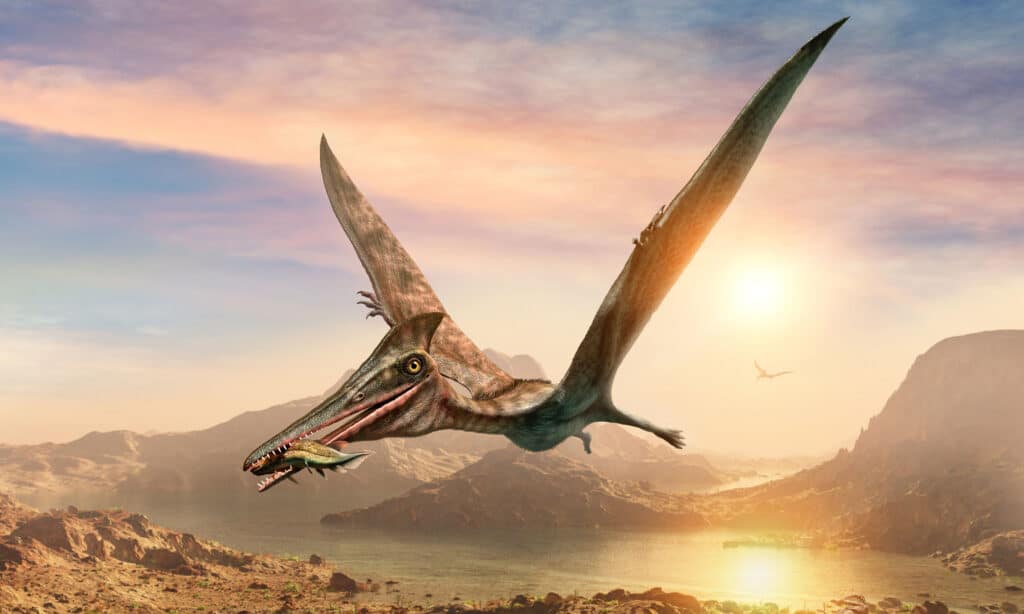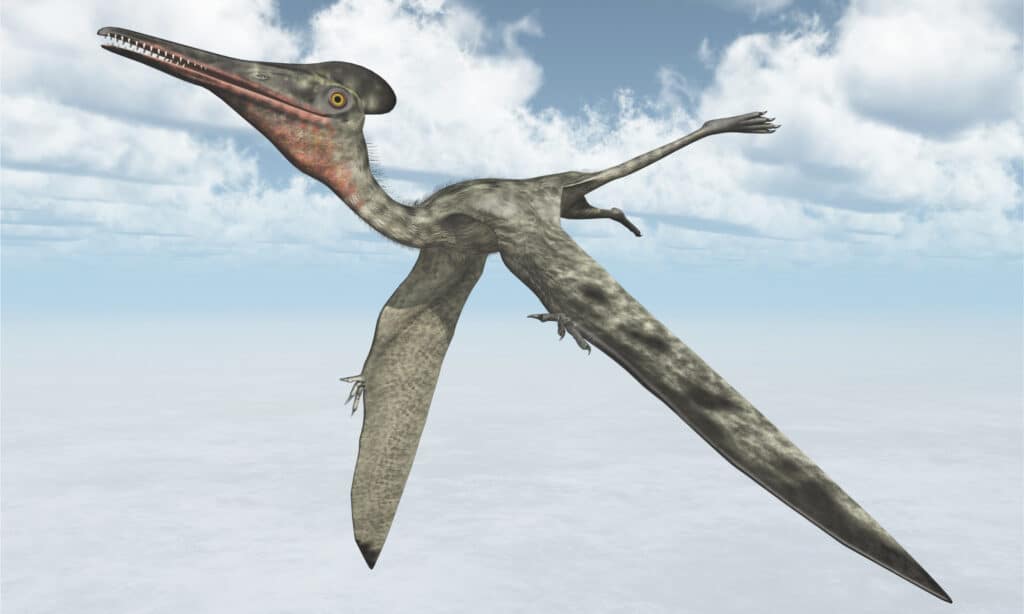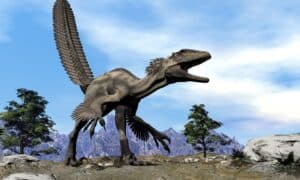Long before birds or bats soared through the skies, another vertebrate developed the ability to fly. A group of reptiles evolved the ability to fly around 215 million years ago. Not merely gliding between high spaces, like some of today’s reptiles can do, these creatures were true fliers. But what about pterosaur vs pterodactyl, what’s the difference and how can you distinguish one from the other?
In popular culture, the terms pterosaur and pterodactyl are sometimes used interchangeably. However, that’s not correct.
A pterodactyl is a type of pterosaur. A pterosaur includes the entire group of prehistoric flying reptiles.
Pterosaur vs Pterodactyl

Pterosaurs are not technically considered
dinosaurs
but are a related cousin of dinosaurs.
©iStock.com/Warpaintcobra
Pterosaurs, of the scientific order Pterosauria, are a group of related species. While pterodactyls (Pterodactylus antiquus) are a type of species within the group.
Pterosaurs include species that range in size from small birds to small airplanes. On the other hand, the average pterodactyl had a wingspan of about three and a half feet.
Were Pterosaurs Dinosaurs?

A pterosaur fossil was found embedded in a rock.
©Dallas Golden/Shutterstock.com
Interestingly, pterosaurs are not technically considered dinosaurs but are a cousin of dinosaurs. Technically, pterosaurs are considered flying reptiles, not dinosaurs. Although dinosaurs and pterosaurs descended from the group, Avemetatarsalia.
When Did Pterosaurs Live?
Pterosaurs roamed the earth from the late Triassic Period to the end of the Cretaceous Period, which is about 228 to 66 million years ago. The last pterosaur went extinct 66 million years ago. Within that group, pterodactyls first showed up around the end of the Jurassic Period.
Facts About Pterosaurs
The term pterosaur comes from a Greek word meaning winged lizards. Pterosaurs were a varied group, and there were two main types: rhamphorhynchoids and pterodactyloids.
Rhamphorhynchoids (basal Pterosauria) were the first pterosaurs to evolve and had long tails. Pterodactyloids descended from rhamphorhynchoids and sported shorter tails.
When pterosaurs fossils were first discovered, archeologists believed the reptiles were not good fliers, but mainly glided through the air, like today’s reptiles. However, further discovery and research helped scientists to determine that these creatures were indeed powerful fliers. With their hollow bones, robust flight muscles, and well-developed large brains, these flying reptiles were at home in the sky.
Pterosaur skulls tended to be long and full of needle-like teeth, although some species were toothless.
The Largest Pterosaur

Named for the Aztec winged serpent god, the quetzalcoatlus may have had a wingspan up to 36 feet long.
©kamomeen/Shutterstock.com
The largest flying reptile that ever existed was the quetzalcoatlus. Named for the Aztec winged serpent god, the quetzalcoatlus had a wingspan of possibly up to 36 feet long (there is some debate over the exact length of the wingspan.) With a long neck, this creature stood as tall as a giraffe at 18 feet tall.
The Smallest Pterosaur
In contrast, the smallest known pterosaur to fly through the skies is the Nemicolopterus, with a wingspan of ten inches. The fossil was found in the western part of China’s Liaoning Province.
Resembling a fuzzy, baby bird the only specimen ever found of this tiny reptile may be a fledgling, although scientists are not certain. There is some debate if the specimen found is indeed its species, or a baby of another small flying reptile, the Sinopterus.
Facts About Pterodactyls

Pterodactyles hunted for fish with their snouts, similar to pelicans.
©Michael Rosskothen/Shutterstock.com
Pterodactyles, a type of pterosaur, had spiky teeth (around 90 of them), narrow jaws, and a long snout. With wingspans of 3.4 feet, they were ferocious predators, they soared the skies searching for their prey. Like birds, they laid eggs and had hollow bones.
But, unlike birds, pterodactyls had fur instead of feathers. The fur consisted of hairlike filaments, called pycnofibers. They were likely warm-blooded, rather than cold-blooded, like today’s modern reptiles.
Pterodactyls didn’t have legs, but instead long fingers, which they could walk on. They feasted on small mammals, insects, small dinosaurs, and fish. Researchers believe they hunted for fish with their snouts, similar to pelicans. Paleontologists believe that pterodactyls probably lived in nests due to the discovery of nests on mountaintops in Papua New Guinea.
Fossil Evidence

Pterodactyl fossils reveal an elongated fourth finger, giving the animal a bat-like appearance and powerful flying abilities.
©Steven U. Vidovic, David M. Martill, Matthew Martyniuk,, CC BY-SA 3.0, via Wikimedia Commons – Original / License
Scientists have had to piece together information on pterosaurs without the vast fossil record other dinosaurs have. The reason pterosaur fossils are so rare is that their hollow bones were fragile and didn’t preserve well. They also tended to live in habitats not suited to preserving fossils. Further, their fossils tend to be fragile and may suffer damage during excavation or transportation.
A pterodactyl specimen found in Italy in 1784 was the first pterosaur fossil ever discovered. The fossil dated back to 220 million years ago, and when scientists first discovered it, they believed it was an aquatic animal that used its wings as paddles in the water.
Since then, nearly complete pterodactyl fossils were found in Brazil, Germany, and Italy.
Thank you for reading! Have some feedback for us? Contact the AZ Animals editorial team.








